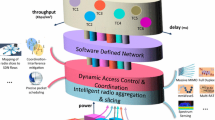Abstract
The rapid advances in software defined radio (SDR) technologies over the past decade encouraged their transition from the lab to field deployment, and shifted the usage from disparate communication devices to the creation of large resilient wireless networks capable of adapting to highly variable environment conditions in a cognitive manner. Simulation models capable of accurately representing the behavior and properties of SDR devices operating in a networked environment thus become a prerequisite for both the evaluation of such networks as well as for providing a development platform for creating new cognitive capabilities. This paper describes our work in creating a network simulation model framework for software defined radios that takes into account some of the unique behaviors and requirements of SDRs not previously seen in purely hardware devices. Factors such as large and variable communication delays between software modules, contention to shared resources, such as CPU or memory, as well as continuous tuning and environment awareness functionality essential to SDR demand a different modeling approach as well as novel techniques that enable accurate scale testing.












Similar content being viewed by others
References
Biswas, P. K., Serban, C., Poylisher, A., Lee, J., Mau, S., Chadha, R., & Chiang, C. J. (2009). An integrated testbed for virtual ad hoc networks. In Proceedings of TRIDENTCOM.
Bose, R., & Ray-Chaudhuri, D. (1960). On a class of error correcting binary group codes. Information and Control, 3, 68–79.
Clausen, T., & Jacquet, P. (2003). Optimized link state routing protocol (OSLR). In IETF Request for Comments RFC (Vol. 3626).
Ge, F., Chiang, C. J., Gottlieb, Y. M., & Chadha, R. (2011). GNU radio based digital communications: Computational analysis of a gmsk transceiver. In IEEE Global Communications Conference (GLOBECOM).
GNU Radio Project page. http://gnuradio.org/redmine/projects/gnuradio/wiki. Accessed 25 July 2013.
Hocquenghem, A. (1959). Codes correcteurs d’erreurs. Chiffres, 2, 147–156.
Poylisher, A., Serban, C., Lee, J., Lu, T. C., Chadha, R., & Chiang, C. J. (2010). A virtual ad hoc network testbed. International Journal of Communication Networks and Distributed Systems, X, 5–24.
Sapello, C. A., Serban, C., Sethi, A., Chiang, C. J., & Moeltner, K. (2013). A software defined radio modeling framework for enabling cognitive application. In Proceedings of SDR-WInnComm 2013, Washington DC
Serban, C., Ge, F., Chiang, C. J., Chadha, R., & Moeltner, K. (2012). A practical platform for cognitive functions in tactical edge networks. In IEEE Military Communications Conference (MILCOM), Orlando, FL.
Serban, C., Poylisher, A., & Chiang, C. J. (2010). Virtual ad hoc network testbeds for network-aware applications. In Proceedings of IEEE/IFIP network operations and management symposium (NOMS 2010).
Sultan, F., Poylisher, A., Serban, C., Lee, J., Chadha, R., Chiang, C. J., & Wittaker, K. (2012). Timesync: Virtual time for scalable, high-fidelity hybrid network emulation. In IEEE military communication conference (MILCOM), Orlando, FL.
Viterbi, A. (1967). Error bounds for convolutional codes and an asymptotically optimal decoding algorithm. IEEE Transactions on Information Theory, 13, 260–269.
Acknowledgments
The research reported in this document/presentation was performed in connection with contract number W15P7T-08-C-P213 with the U.S. Army Communications Electronics Research and Development Engineering Center (CERDEC). The views and conclusions contained in this document are those of the authors and should not be interpreted as presenting the official policies or position, either expressed or implied, of the U.S. Army CERDEC, or the U.S. Government unless so designated by other authorized documents. Citation of manufacturer’s or trade names does not constitute an official endorsement or approval of the use thereof. The U.S. Government is authorized to reproduce and distribute reprints for Government purposes notwithstanding any copyright notation hereon.
Author information
Authors and Affiliations
Corresponding author
Rights and permissions
About this article
Cite this article
Sapello, A., Sethi, A., Serban, C. et al. A software defined radio modeling framework for enabling cognitive applications. Analog Integr Circ Sig Process 78, 543–556 (2014). https://doi.org/10.1007/s10470-013-0104-0
Received:
Revised:
Accepted:
Published:
Issue Date:
DOI: https://doi.org/10.1007/s10470-013-0104-0




